+ Open data
Open data
- Basic information
Basic information
| Entry |  | |||||||||
|---|---|---|---|---|---|---|---|---|---|---|
| Title | Cryo-EM structure of pentameric proteorhodopsin A18L mutant | |||||||||
 Map data Map data | ||||||||||
 Sample Sample |
| |||||||||
 Keywords Keywords | Membrane protein / Light-driven proton pump / Proteorhodopsin / PROTON TRANSPORT | |||||||||
| Function / homology |  Function and homology information Function and homology informationlight-activated monoatomic ion channel activity / photoreceptor activity / phototransduction / plasma membrane Similarity search - Function | |||||||||
| Biological species |  uncultured Gammaproteobacteria bacterium (environmental samples) uncultured Gammaproteobacteria bacterium (environmental samples) | |||||||||
| Method | single particle reconstruction / cryo EM / Resolution: 2.82 Å | |||||||||
 Authors Authors | Hirschi S / Lemmin T / Fotiadis D | |||||||||
| Funding support |  Switzerland, 1 items Switzerland, 1 items
| |||||||||
 Citation Citation |  Journal: Nat Commun / Year: 2024 Journal: Nat Commun / Year: 2024Title: Structural insights into the mechanism and dynamics of proteorhodopsin biogenesis and retinal scavenging. Authors: Stephan Hirschi / Thomas Lemmin / Nooraldeen Ayoub / David Kalbermatter / Daniele Pellegata / Zöhre Ucurum / Jürg Gertsch / Dimitrios Fotiadis /   Abstract: Microbial ion-pumping rhodopsins (MRs) are extensively studied retinal-binding membrane proteins. However, their biogenesis, including oligomerisation and retinal incorporation, remains poorly ...Microbial ion-pumping rhodopsins (MRs) are extensively studied retinal-binding membrane proteins. However, their biogenesis, including oligomerisation and retinal incorporation, remains poorly understood. The bacterial green-light absorbing proton pump proteorhodopsin (GPR) has emerged as a model protein for MRs and is used here to address these open questions using cryo-electron microscopy (cryo-EM) and molecular dynamics (MD) simulations. Specifically, conflicting studies regarding GPR stoichiometry reported pentamer and hexamer mixtures without providing possible assembly mechanisms. We report the pentameric and hexameric cryo-EM structures of a GPR mutant, uncovering the role of the unprocessed N-terminal signal peptide in the assembly of hexameric GPR. Furthermore, certain proteorhodopsin-expressing bacteria lack retinal biosynthesis pathways, suggesting that they scavenge the cofactor from their environment. We shed light on this hypothesis by solving the cryo-EM structure of retinal-free proteoopsin, which together with mass spectrometry and MD simulations suggests that decanoate serves as a temporary placeholder for retinal in the chromophore binding pocket. Further MD simulations elucidate possible pathways for the exchange of decanoate and retinal, offering a mechanism for retinal scavenging. Collectively, our findings provide insights into the biogenesis of MRs, including their oligomeric assembly, variations in protomer stoichiometry and retinal incorporation through a potential cofactor scavenging mechanism. | |||||||||
| History |
|
- Structure visualization
Structure visualization
| Supplemental images |
|---|
- Downloads & links
Downloads & links
-EMDB archive
| Map data |  emd_16795.map.gz emd_16795.map.gz | 20.9 MB |  EMDB map data format EMDB map data format | |
|---|---|---|---|---|
| Header (meta data) |  emd-16795-v30.xml emd-16795-v30.xml emd-16795.xml emd-16795.xml | 14.4 KB 14.4 KB | Display Display |  EMDB header EMDB header |
| Images |  emd_16795.png emd_16795.png | 210.8 KB | ||
| Filedesc metadata |  emd-16795.cif.gz emd-16795.cif.gz | 5.4 KB | ||
| Others |  emd_16795_half_map_1.map.gz emd_16795_half_map_1.map.gz emd_16795_half_map_2.map.gz emd_16795_half_map_2.map.gz | 20.4 MB 20.4 MB | ||
| Archive directory |  http://ftp.pdbj.org/pub/emdb/structures/EMD-16795 http://ftp.pdbj.org/pub/emdb/structures/EMD-16795 ftp://ftp.pdbj.org/pub/emdb/structures/EMD-16795 ftp://ftp.pdbj.org/pub/emdb/structures/EMD-16795 | HTTPS FTP |
-Validation report
| Summary document |  emd_16795_validation.pdf.gz emd_16795_validation.pdf.gz | 738.5 KB | Display |  EMDB validaton report EMDB validaton report |
|---|---|---|---|---|
| Full document |  emd_16795_full_validation.pdf.gz emd_16795_full_validation.pdf.gz | 738.1 KB | Display | |
| Data in XML |  emd_16795_validation.xml.gz emd_16795_validation.xml.gz | 10.4 KB | Display | |
| Data in CIF |  emd_16795_validation.cif.gz emd_16795_validation.cif.gz | 12.1 KB | Display | |
| Arichive directory |  https://ftp.pdbj.org/pub/emdb/validation_reports/EMD-16795 https://ftp.pdbj.org/pub/emdb/validation_reports/EMD-16795 ftp://ftp.pdbj.org/pub/emdb/validation_reports/EMD-16795 ftp://ftp.pdbj.org/pub/emdb/validation_reports/EMD-16795 | HTTPS FTP |
-Related structure data
| Related structure data | 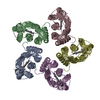 8cqcMC 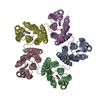 8cnkC 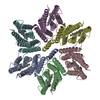 8cqdC M: atomic model generated by this map C: citing same article ( |
|---|---|
| Similar structure data | Similarity search - Function & homology  F&H Search F&H Search |
- Links
Links
| EMDB pages |  EMDB (EBI/PDBe) / EMDB (EBI/PDBe) /  EMDataResource EMDataResource |
|---|---|
| Related items in Molecule of the Month |
- Map
Map
| File |  Download / File: emd_16795.map.gz / Format: CCP4 / Size: 22.2 MB / Type: IMAGE STORED AS FLOATING POINT NUMBER (4 BYTES) Download / File: emd_16795.map.gz / Format: CCP4 / Size: 22.2 MB / Type: IMAGE STORED AS FLOATING POINT NUMBER (4 BYTES) | ||||||||||||||||||||||||||||||||||||
|---|---|---|---|---|---|---|---|---|---|---|---|---|---|---|---|---|---|---|---|---|---|---|---|---|---|---|---|---|---|---|---|---|---|---|---|---|---|
| Projections & slices | Image control
Images are generated by Spider. | ||||||||||||||||||||||||||||||||||||
| Voxel size | X=Y=Z: 1.0047 Å | ||||||||||||||||||||||||||||||||||||
| Density |
| ||||||||||||||||||||||||||||||||||||
| Symmetry | Space group: 1 | ||||||||||||||||||||||||||||||||||||
| Details | EMDB XML:
|
-Supplemental data
-Half map: #2
| File | emd_16795_half_map_1.map | ||||||||||||
|---|---|---|---|---|---|---|---|---|---|---|---|---|---|
| Projections & Slices |
| ||||||||||||
| Density Histograms |
-Half map: #1
| File | emd_16795_half_map_2.map | ||||||||||||
|---|---|---|---|---|---|---|---|---|---|---|---|---|---|
| Projections & Slices |
| ||||||||||||
| Density Histograms |
- Sample components
Sample components
-Entire : Pentameric proteorhodopsin A18L
| Entire | Name: Pentameric proteorhodopsin A18L |
|---|---|
| Components |
|
-Supramolecule #1: Pentameric proteorhodopsin A18L
| Supramolecule | Name: Pentameric proteorhodopsin A18L / type: complex / ID: 1 / Parent: 0 / Macromolecule list: #1 |
|---|---|
| Source (natural) | Organism:  uncultured Gammaproteobacteria bacterium (environmental samples) uncultured Gammaproteobacteria bacterium (environmental samples) |
-Macromolecule #1: Green-light absorbing proteorhodopsin
| Macromolecule | Name: Green-light absorbing proteorhodopsin / type: protein_or_peptide / ID: 1 / Number of copies: 5 / Enantiomer: LEVO |
|---|---|
| Source (natural) | Organism:  uncultured Gammaproteobacteria bacterium (environmental samples) uncultured Gammaproteobacteria bacterium (environmental samples) |
| Molecular weight | Theoretical: 28.110854 KDa |
| Recombinant expression | Organism:  |
| Sequence | String: MGKLLLILGS VIALPTFLAG GGDLDASDYT GVSFWLVTAA LLASTVFFFV ERDRVSAKWK TSLTVSGLVT GIAFWHYMYM RGVWIETGD SPTVFRYIDW LLTVPLLICE FYLILAAATN VAGSLFKKLL VGSLVMLVFG YMGEAGIMAA WPAFIIGCLA W VYMIYELW ...String: MGKLLLILGS VIALPTFLAG GGDLDASDYT GVSFWLVTAA LLASTVFFFV ERDRVSAKWK TSLTVSGLVT GIAFWHYMYM RGVWIETGD SPTVFRYIDW LLTVPLLICE FYLILAAATN VAGSLFKKLL VGSLVMLVFG YMGEAGIMAA WPAFIIGCLA W VYMIYELW AGEGKSACNT ASPAVQSAYN TMMYIIIFGW AIYPVGYFTG YLMGDGGSAL NLNLIYNLAD FVNKILFGLI IW NVAVKES SNAGHHHHH UniProtKB: Green-light absorbing proteorhodopsin |
-Macromolecule #2: RETINAL
| Macromolecule | Name: RETINAL / type: ligand / ID: 2 / Number of copies: 5 / Formula: RET |
|---|---|
| Molecular weight | Theoretical: 284.436 Da |
| Chemical component information | 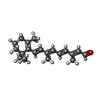 ChemComp-RET: |
-Macromolecule #3: water
| Macromolecule | Name: water / type: ligand / ID: 3 / Number of copies: 30 / Formula: HOH |
|---|---|
| Molecular weight | Theoretical: 18.015 Da |
| Chemical component information |  ChemComp-HOH: |
-Experimental details
-Structure determination
| Method | cryo EM |
|---|---|
 Processing Processing | single particle reconstruction |
| Aggregation state | particle |
- Sample preparation
Sample preparation
| Concentration | 4.2 mg/mL |
|---|---|
| Buffer | pH: 7.5 |
| Vitrification | Cryogen name: ETHANE / Instrument: FEI VITROBOT MARK IV |
- Electron microscopy
Electron microscopy
| Microscope | FEI TITAN KRIOS |
|---|---|
| Image recording | Film or detector model: GATAN K3 (6k x 4k) / Average electron dose: 49.8 e/Å2 |
| Electron beam | Acceleration voltage: 300 kV / Electron source:  FIELD EMISSION GUN FIELD EMISSION GUN |
| Electron optics | Illumination mode: OTHER / Imaging mode: BRIGHT FIELD / Nominal defocus max: 1.7 µm / Nominal defocus min: 0.7000000000000001 µm / Nominal magnification: 105000 |
| Experimental equipment |  Model: Titan Krios / Image courtesy: FEI Company |
- Image processing
Image processing
| Startup model | Type of model: NONE |
|---|---|
| Final reconstruction | Applied symmetry - Point group: C5 (5 fold cyclic) / Resolution.type: BY AUTHOR / Resolution: 2.82 Å / Resolution method: FSC 0.143 CUT-OFF / Software - Name: cryoSPARC / Number images used: 709759 |
| Initial angle assignment | Type: ANGULAR RECONSTITUTION |
| Final angle assignment | Type: ANGULAR RECONSTITUTION |
 Movie
Movie Controller
Controller



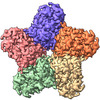




 Z (Sec.)
Z (Sec.) Y (Row.)
Y (Row.) X (Col.)
X (Col.)




































